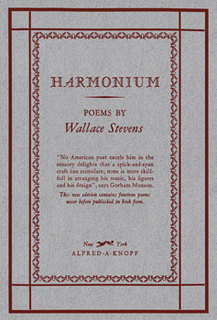Related Research Articles

Harmonium is a book of poetry by American poet Wallace Stevens. His first book at the age of forty-four, it was published in 1923 by Knopf in an edition of 1500 copies. This collection comprises 85 poems, ranging in length from just a few lines to several hundred. Harmonium was reissued in 1931 with three poems omitted and fourteen new poems added.
Badroulbadour/ Badr ul-Badour/ Badr al-Badur is a princess whom Aladdin married in The Story of Aladdin; or, the Wonderful Lamp. Her name uses the full moon as a metaphor for female beauty, which is common in Arabic literature and throughout the Arabian Nights.
"The Paltry Nude Starts on a Spring Voyage" is a poem from Wallace Stevens's first book, Harmonium. Originally published in 1919, it is in the public domain. Despite general agreement that it is indebted to Botticelli's The Birth of Venus, there is uncertainty about the nature of the debt.
"Cy est Pourtraicte, Madame Ste Ursule, et les Unze Mille Vierges" is a poem in Wallace Stevens's first book of poetry, Harmonium. It was first published in 1915 in the magazine Rogue, so it is in the public domain. Butell characterizes it as one of the first two poems to "successfully combine wit and elegance". They are the earliest poems to be collected later in Harmonium.
"The Doctor of Geneva" is a poem from Wallace Stevens's first book of poetry, Harmonium (1923). The poem was first published in 1921, so it is free of copyright.
"O Florida, Venereal Soil" is a poem from Wallace Stevens's first book of poetry, Harmonium. It was first published in the journal Dial, volume 73, July 1922, and is therefore in the public domain.
"The Jack-Rabbit" is a poem from Wallace Stevens's first book of poetry, Harmonium (1923).
"The Apostrophe to Vincentine" is a poem from Wallace Stevens's first book of poetry, Harmonium (1923). It was first published before 1923 and is therefore in the public domain according to Librivox.
"Anecdote of Canna" is a poem from Wallace Stevens's first book of poetry, Harmonium (1923).
"Of Heaven Considered as a Tomb" is a poem from Wallace Stevens's first book of poetry, Harmonium (1923). It was first published in 1921, so it is in the public domain.
"Banal Sojourn" is a poem from Wallace Stevens's first book of poetry, Harmonium. It was originally published in 1919, therefore it is in the public domain.
"Stars at Tallapoosa" is a poem from Wallace Stevens's first book of poetry, Harmonium. It was first published in 1922, so it is in the public domain.
"Six Significant Landscapes" is a poem from Wallace Stevens's first book of poetry, Harmonium. It was first published in 1916, so it is in the public domain.
"Frogs Eat Butterflies. Snakes Eat Frogs. Hogs Eat Snakes. Men Eat Hogs." is a poem from Wallace Stevens's first book of poetry, Harmonium. It was first published in The Dial in 1922 and is therefore in the public domain.
"Cortege for Rosenbloom" is a poem from Wallace Stevens's first book, Harmonium. First published in 1921, it is in the public domain in the United States and similar jurisdictions.
"Thirteen Ways of Looking at a Blackbird" is a poem from Wallace Stevens's first book of poetry, Harmonium. The poem consists of thirteen short, separate sections, each of which mentions blackbirds in some way. Although inspired by haiku, none of the sections meets the traditional definition of haiku. It was first published in October 1917 by Alfred Kreymborg in Others: An Anthology of the New Verse and two months later in the December issue of Others: A Magazine of the New Verse.
"To the One of Fictive Music" is a poem from Wallace Stevens's first book of poetry, Harmonium. First published in 1922, it is in the public domain.
"Hymn From A Watermelon Pavilion" is a poem from Wallace Stevens's first book of poetry, Harmonium. It was first published in 1917, so it is in the public domain.
"The Death of a Soldier" is a poem from Wallace Stevens's first book of poetry, Harmonium. The poem uses free verse to describe the death of a soldier.
"Sea Surface full of Clouds" is a poem from the second, 1931, edition of Wallace Stevens's first book of poetry, Harmonium. It was first published in 1924, so it is restricted by copyright. However, brief parts of it are quoted here as fair use, and the whole poem is available elsewhere on the Internet.
References
- Buttel, R. Wallace Stevens: The Making of Harmonium. 1968: Princeton University Press.
- Kermode, Frank and Joan Richardson, eds. Stevens: Collected Poetry & Prose. 1997: The Library of America.